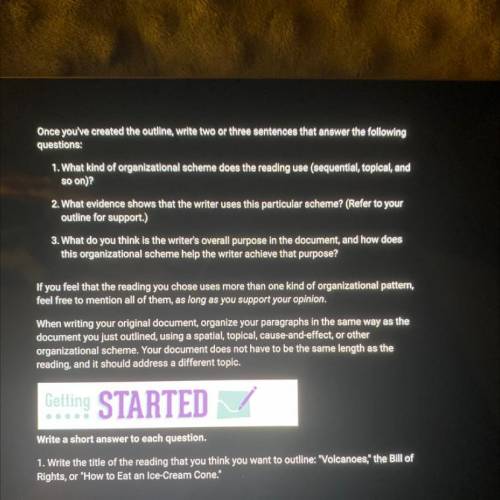
English, 05.02.2022 20:50 annapittbull12
Convert one of the readings from the lesson into an outline that shows how the
document is organized. Then write a new document of 300 to 500 words that is
organized in the same way but about a completely different topic. For example, if you
outline one of the readings and determine that it uses sequential organization, use
sequential organization in your own document.
In the outline, arrange the content of your chosen reading into topics (and, if necessary,
subtopics) and provide short phrases or sentences that describe the important details
(for example, lists instructions for how to take the ice-cream cone from the cashier).
Once you've created the outline, write two or three sentences that answer the following
1. What kind of organizational scheme does the reading use (sequential, topical, and
so on)?
2 What evidence shows that the writer uses this particular scheme? (Refer to your


Answers: 2


Another question on English


English, 21.06.2019 19:00
Read this excerpt from tim o’brien‘s “ambush” “i had already pulled the pin on a grenade. i had come to a crouch” which literary device is most clearly shown in this excerpt?
Answers: 1

English, 21.06.2019 20:50
Select the correct answer. lyric poems often deal with intense emotions. which statement best describes the shift in emotion in "lift every voice and sing" as it moves from the first into the second stanza? lift every voice and sing till earth and heaven ring, ring with the harmonies of liberty; let our rejoicing rise high as the listening skies, let it resound loud as the rolling sea. sing a song full of the faith that the dark past has taught us, sing a song full of the hope that the present has brought us, facing the rising sun of our new day begun let us march on till victory is won. stony the road we trod, bitter the chastening rod, felt in the days when hope unborn had died; yet with a steady beat, have not our weary feet come to the place for which our fathers sighed? we have come over a way that with tears has been watered, we have come, treading our path through the blood of the slaughtered, out from the gloomy past, till now we stand at last where the white gleam of our bright star is cast. a. the joyful call of the first stanza gives way to a bitter recounting of history in the second. b. the first stanza's anger is replaced by the second stanza's resignation. c. the poem moves from a sense of wonder in the first stanza toward a sense of perplexity in the second. d. there is no change between the first stanza and the second. the emotions are the same in both.
Answers: 3

English, 22.06.2019 00:30
In at least 150 words, identify and describe the setting, and the way the author uses imagery to describe it for part 1 of nectar in a sieve.
Answers: 1
You know the right answer?
Convert one of the readings from the lesson into an outline that shows how the
document is organiz...
Questions


Social Studies, 04.08.2019 10:10

Mathematics, 04.08.2019 10:10

History, 04.08.2019 10:10



Mathematics, 04.08.2019 10:10

History, 04.08.2019 10:10



Mathematics, 04.08.2019 10:10


Mathematics, 04.08.2019 10:10



Biology, 04.08.2019 10:10



Mathematics, 04.08.2019 10:10



